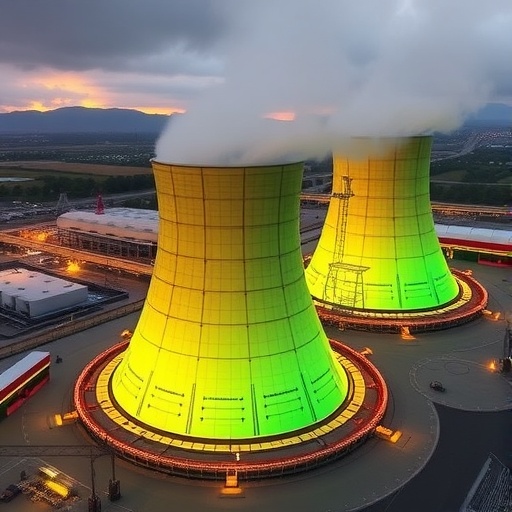
MIT has unveiled a groundbreaking advancement in the field of nuclear engineering with a pioneering technique that enables real-time, three-dimensional monitoring of material degradation phenomena such as corrosion and cracking within the harsh environments of nuclear reactors. This innovative approach takes significant strides towards enhancing nuclear reactor safety and performance, paving the way for their extended operational life and efficiency in applications like electricity generation and naval propulsion. By mimicking the behavior of neutrons, the MIT researchers employed exceptionally intense X-rays to investigate how materials behave under conditions akin to those found inside a nuclear reactor.
During their extensive experimentation, researchers identified that implementing a silicon dioxide buffer layer between the reactor material and its substrate significantly bolster the stability of the sample when subjecting it to X-ray irradiation. Keeping the material in the beam for an extended duration was instrumental in easing the strain within the material, thereby allowing the team to conduct real-time observations of material deterioration processes. This novel application of X-ray technology not only marks a pivotal moment in nuclear engineering but also holds implications for other fields, emphasizing the necessity of understanding material vulnerabilities before they lead to catastrophic failures.
As the complexity of nuclear materials poses considerable challenges, the ability to reconstruct detailed three-dimensional imagery of materials as they undergo failure allows scientists to engineer more resilient substances capable of withstanding high levels of radiation. Ericmoore Jossou, the principal investigator and a professor at MIT, articulated the profound impact this technique could have on the lifespan of nuclear reactors. Improved materials signify a lower frequency of failures, extending the usability of reactors into the future. His sentiments highlight the urgency for advancing our understanding of material behavior under duress, especially in environments where failures can have severe implications.
The innovative methodology developed by the MIT team was documented in a recent paper co-authored by graduate and postdoctoral researchers working closely with Jossou. The collaborative effort, including contributions from experts affiliated with prominent synchrotron facilities, illustrates the interdisciplinary nature of modern scientific investigations. The study underscores that unprecedented results can be achieved when expertise from various domains converges to address communal challenges. The insights gleaned from this research not only contribute to the field of nuclear science but also provide fundamental knowledge applicable to other realms of material science.
The methodology that the researchers utilized involved a rigorous process of sample preparation, where nickel, a critical component of alloys used in advanced reactor designs, was subjected to solid-state dewetting. This involved applying a thin film of nickel atop a substrate and escalating the temperature to transform it into single crystals. The initial phases of the experiment faced hurdles due to unwanted interactions between nickel and the silicon substrate. Eventually, the inclusion of a silicon dioxide barrier allowed the team to advance their research without detrimental reactions influencing the outcomes of their experiments.
One remarkable revelation emerged from their studies: extending the exposure time to X-ray beams resulted in a relaxation of the strain within the crystals formed. The team discovered this relaxation was facilitated by the silicon dioxide buffer layer, which proved vital for obtaining accurate 3D reconstructions of the crystal shape and size under real-time conditions. This advancement could revolutionize the monitoring of materials used in nuclear reactors, enabling real-time assessments during operational stress conditions.
Furthermore, the researchers unearthed another fascinating consequence of their findings – not only could they observe the material’s failure processes in three dimensions, but they could also employ the X-ray beam to exert control over the strain levels in the crystal structure. This capability bears profound implications for microelectronics, as the ability to fine-tune strain during manufacturing processes could significantly enhance the performance characteristics of electronic materials. While initially unintended, this dual-functionality highlights the often serendipitous nature of scientific discovery.
As the domain of nuclear engineering continues to evolve, the MIT team is enthusiastic about extending their technique to explore more complex materials, such as various alloys utilized within reactor contexts and aerospace applications. This forward-thinking approach aligns with their vision of developing safer, more efficient reactor designs by understanding how different materials respond to radiation and thermal stress. The interplay between the thickness of the silicon dioxide buffer layer and strain control will also be a focal point of future studies to further refine their methodology.
In conclusion, MIT’s breakthrough technique not only enhances the understanding of material failures in the demanding environments of nuclear reactors but it also has potential repercussions across multiple fields. By integrating high-intensity X-ray technology with advances in materials science, this research underscores the importance of viewing scientific challenges through a multifaceted lens. As the researchers continue to explore innovative solutions, the foundations laid by this study open new avenues for safer, more efficient technology in energy production and beyond.
Subject of Research: Real-time 3D monitoring of material failure processes in nuclear reactor environments
Article Title: “X-ray irradiation induced strain relaxation of dewetted Ni particles on modified Si substrate”
News Publication Date: Tuesday (exact date not specified in the content)
Web References: Link to article
References: DOI 10.1016/j.scriptamat.2025.116940
Image Credits: No image credits provided.
Keywords
Tags: advanced X-ray technology applicationscorrosion detection in nuclear reactorscracking analysis in reactor materialsenhancing nuclear reactor efficiencyextended operational life of reactorsimplications for nuclear engineering advancementsmaterial degradation phenomena in engineeringneutron behavior simulation in materialsnuclear reactor safetypreventing catastrophic failures in nuclear systemsreal-time material monitoring techniquessilicon dioxide buffer layer benefits




